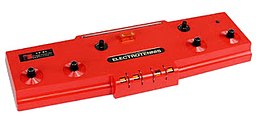The TV Tennis Electrotennis (Japanese: テレビテニス,[1][2] Hepburn romanzination: Terebitenisu, meaning Television Tennis,[2] commonly abbreviated as TV Tennis or Electrotennis) is a dedicated first-generation home video game console that was released by Epoch Co. (developed in cooperation with Magnavox)[3] on September 12, 1975[1][2] for 19,000 Japanese yen[1][2] only in Japan. It was the first video game console released in Japan.[1][2][3]
 A TV Tennis Electrotennis | |
| Also known as |
|
|---|---|
| Manufacturer | Epoch Co. (developed with Magnavox) |
| Type | Dedicated home video game console |
| Generation | First generation |
| Release date | Japan: September 12, 1975 |
| Introductory price | 19,000 Japanese yen |
| Units sold | Not clear; around 10,000, 20,000 or 3 million |
| Successor | TV Game System 10 |
It was released several months before the release of Home Pong in North America. One unique feature of the TV Tennis Electrotennis is that the console is connected wirelessly to a TV, functioning through an UHF antenna.[4] Depending on the source, it sold about 10,000,[2] 20,000[5] or 3 million units[1] in its lifetime, including about 5,000 units in the first year.[citation needed]
Legacy
editThe successor of the TV Tennis Electrotennis is the TV Game System 10 from 1977. It includes as a light gun a plastic replica of a Mauser C96;[6][7] the C96 replica was also usable with its next console, the Epoch Cassette Vision, created in 1981.[8]
The wireless broadcast functionality of the TV Tennis Electrotennis got Nintendo designer Masayuki Uemura to consider adding that capability to the Famicom (Nintendo Entertainment System), though he ultimately did not pursue it to keep system costs low.[9]
References
edit- ^ a b c d e "Retro-Gaming: Die allererste japanische Videospielkonsole feiert 40. Jubiläum". January 22, 2019. Archived from the original on January 22, 2019. Retrieved November 10, 2020.
- ^ a b c d e f toarcade (September 12, 2015). "Japan's 1st Video Game Console was released 40 Years ago!". Toarcade. Retrieved March 13, 2019.
- ^ a b "エポック社沿革". epoch.jp (in Japanese). Archived from the original on October 11, 2007. Retrieved March 14, 2020.
- ^ Martin Picard, The Foundation of Geemu: A Brief History of Early Japanese video games, International Journal of Computer Game Research, 2013
- ^ 藤田, 直樹 (March 1999). "「ファミコン」登場前の日本ビデオ・ゲーム産業 ―現代ビデオ・ゲーム産業の形成過程(2)―". 經濟論叢. 163 (3): 59–76. doi:10.14989/45271. ISSN 0013-0273.
- ^ "Epoch TV Game System 10". Centre for Computing History UK. Retrieved August 23, 2021.
- ^ "The Forgotten Epic: Epoch TV Game System 10". TheGameScholar.com. June 10, 2020. Retrieved August 23, 2021.
- ^ "Epoch and the Cassette Vision – 1997 Developer Interview with hardware engineer/designer Masayuki Horie". ShmupLations.com. Retrieved August 23, 2021.
- ^ "Feature: NES Creator Masayuki Uemura On Building The Console That Made Nintendo A Household Name". Nintendo Life. March 3, 2020. Retrieved October 30, 2020.